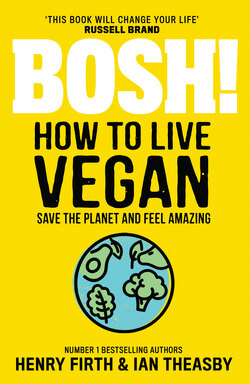Читать книгу BOSH! How to Live Vegan - Henry Firth - Страница 27
SO HOW EXACTLY DOES EATING VEGAN HELP?
ОглавлениеAll the energy we ingest through food has, originally, come from plants. This is the energy cycle we learned about in school. We are able to harvest and eat those plants to get all the energy, nutrients, minerals and vitamins we need from them (more on this later).
When we rear animals for eating, we take this efficient form of plant energy and use it to sustain animals, like cows and sheep, so we can eat them later. This is much less efficient! Also, since animals are living creatures, most of their food is actually used for energy for their own day-to-day activity. Only a tiny fraction of the nutrients and energy in the food they eat ends up in the meat we buy. Cows convert only 4% of the proteins and 3% of the calories of the plants we feed them into beef[45] – 97% of the calories they consume is completely lost to us. To produce 1kg of beef requires over 13,000 litres of water, a water footprint six times larger than for pulses.[46] Meat accounts for 22% of all water use.[47]
According to researcher Joseph Poore, from Oxford University, about 55% of the world’s land is farmed, and 80–85% of this is used to raise animals.[48] If as much of the land currently set aside for grazing animals regrows as trees, it will help remove carbon from the atmosphere – it is estimated there could be a reduction in greenhouse gases by as much as 30–50%. In addition, more than a billion extra tons of food crops could go to humans if we stopped feeding them to animals. [49]
So not only is a plant-based diet better for the planet in terms of the processes involved in rearing animals, but it can free up land for animals to live naturally again, and trees can grow in those spaces, which can then start to reduce the amount of carbon in the atmosphere. This is still the best approach for getting carbon out of the atmosphere – known as rewilding. It involves restoring natural forests, mangroves, salt marshes and seagrass beds. These natural habitats are the best way researchers have identified of removing carbon dioxide from the atmosphere. And it would solve both climate breakdown and the extinction of species at the same time.[50]
Of course, we’re not suggesting it’s as simple as everyone, worldwide, stopping eating meat and redistributing the grain set aside to feed animals to hungry people while we all start planting trees. At the global level we need to consider the complexities of politics, the mechanisms of food distribution and the realities of farmers’ livelihoods. And at the local level we need to consider things like soil health, crop cycling and animal habitats.
We’re not claiming there’s some kind of magic solution, but the answer lies in this direction. These facts go to show how inefficient our current main choice of protein is, and why it’s literally chewing up the Earth’s resources.
